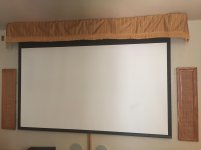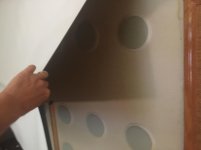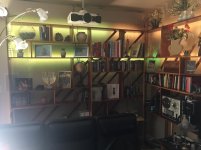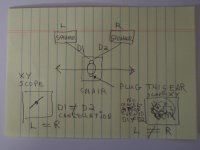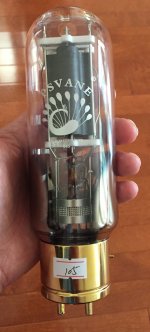Superb thread, I've finally caught up with reading it from start to end! Ive been also musing about building a big amp - either 845 or 100TH. I have one 100TH bulb (and a 250TH, and a few even bigger ones as well, but the heat they produce! - not good in Hawaii). After I lit up the 100TH I knew it will be sitting in the best sounding amp to grace my house (in the future; ), so consider me hooked. I also have a 845 floating around, so my dilemma now is which to choose as the first big amp project (I'm going to build BOTH eventually).
I'm currently running 807 in SE, with 700V on the plate - I guess that got me halfway to the big tube land, 700V being a very modest plate voltage for any of the big beasties, but the one I'm rather not pushing any higher at the moment. (Although the 807 sounded absolutely transcendant at 825V! - a league ahead from the 700V, but that was too scary high voltage to keep around).
JohnnoG, I've been using something similar to your idea - mono with two speakers. Using 2 speakers to project a mono image has way better results than using a single speaker (to my ears). Mono from a single speaker sounds bodiless and hollow to me, but using 2 speakers it comes alive from the space between the 2 speakers.
Indeed, I also experience that the instruments are on the centerline, but each has different size body, each is at a different distance from me, and at different height (as each instrument was at a different distance from the mike). The sound fills the room just as a proper stereo recording does. (If I don't tell we are listening to mono, nobody spotted this so far, just comments about the superb imaging... jawdrops when I tell we've been listening to mono.)
Well, I use mono cartridge (AT33MONO) and have 400+ mono recordings, so I'm not fussing about converting stereo to mono. The dynamics of the old mono recordings, and the spatial coherence is just stellar, stereo recordings are not in the ballpark (there are junk mono recordings too, not all of them are aces ; ). The neat thing about the AT33MONO cartridge is that it has vertical compliance, so it can also track stereo records (but it's a true mono, so it has mono output). So, this type of thing might be the ticket for practical lossless stereo - mono conversion. 🙂
I'm currently running 807 in SE, with 700V on the plate - I guess that got me halfway to the big tube land, 700V being a very modest plate voltage for any of the big beasties, but the one I'm rather not pushing any higher at the moment. (Although the 807 sounded absolutely transcendant at 825V! - a league ahead from the 700V, but that was too scary high voltage to keep around).
JohnnoG, I've been using something similar to your idea - mono with two speakers. Using 2 speakers to project a mono image has way better results than using a single speaker (to my ears). Mono from a single speaker sounds bodiless and hollow to me, but using 2 speakers it comes alive from the space between the 2 speakers.
Indeed, I also experience that the instruments are on the centerline, but each has different size body, each is at a different distance from me, and at different height (as each instrument was at a different distance from the mike). The sound fills the room just as a proper stereo recording does. (If I don't tell we are listening to mono, nobody spotted this so far, just comments about the superb imaging... jawdrops when I tell we've been listening to mono.)
Well, I use mono cartridge (AT33MONO) and have 400+ mono recordings, so I'm not fussing about converting stereo to mono. The dynamics of the old mono recordings, and the spatial coherence is just stellar, stereo recordings are not in the ballpark (there are junk mono recordings too, not all of them are aces ; ). The neat thing about the AT33MONO cartridge is that it has vertical compliance, so it can also track stereo records (but it's a true mono, so it has mono output). So, this type of thing might be the ticket for practical lossless stereo - mono conversion. 🙂
THE 100TH is very different tube than the 845 has very high plate resistance the 845 very low. You need to use a mosfet or Cathode follower 6BL7 needs Positive bias. Best positive tube to use is the 811 or 572 only needs 600 volts for 100 watts
Member
Joined 2009
Paid Member
Mono from a single speaker sounds bodiless and hollow to me, but using 2 speakers it comes alive
The type of speaker and the room may be really key to how you find mono with a single speaker. Using a speaker with good angular dispersion, perhaps better of open baffle, allows the speaker to interact with the room and produce sound that arrives at your ears from more than just straight from the speaker. The sound fills the room better. Just a thought.
The sound has to fill your mind not the room! 😀 If you fill the room you surely create more confusion from the perception point of view because the room has its own character and 99.9% of the time has a negative impact on the information you receive. So the room interaction should minimized.
I find the efforts to make stereo work in the room are worth it.
I will always remember someone said that you need to check a sound system in mono to judge it.
I had not choice but to take this statement from the genius person and apply it religiously.
It is too tempting to listen 5 seconds in mono, say ok, it should work , then jump to stereo modules right away. It led me astray all the time.
I will always remember someone said that you need to check a sound system in mono to judge it.
I had not choice but to take this statement from the genius person and apply it religiously.
It is too tempting to listen 5 seconds in mono, say ok, it should work , then jump to stereo modules right away. It led me astray all the time.
I will always remember someone said that you need to check a sound system in mono to judge it.
Somewhere about 1971 a recording engineer told me to always sound check a mix in mono as well as stereo. The reason being that some unusual phase shifts can cause parts of the spectrum to vanish when summed to mono.
I once went to visit a music teacher who had a fine 1960's vintage stereo system in her house that didn't sound right. To me the problem was obvious when the sound heard in the next room almost vanished when switched to mono.......her speakers were wired out of phase.
Member
Joined 2009
Paid Member
The sound has to fill your mind not the room! 😀 If you fill the room you surely create more confusion from the perception point of view because the room has its own character and 99.9% of the time has a negative impact on the information you receive. So the room interaction should minimized.
After many years I find that it is better to let the room have it’s character, live with it not fight it. Too many artifacts with stereo whether from the room or recording method and mixing.
My room has own character. Bass traps behind the movie screen, a big bookshelf from floor to bottom at the rear wall, with shelves made with random golden ratio dimensions, and a mattress topper behind it. 🙂
When walking in the living room, reverberation changes in the part where sofas stand, where we watch movies. 🙂
When walking in the living room, reverberation changes in the part where sofas stand, where we watch movies. 🙂
Attachments
Wavebourn,
Golden Ratio Dimensions. Neat.
Did you ever shoot with a medium format 6 x 7 film camera?
Golden Ratio Dimensions. Neat.
Did you ever shoot with a medium format 6 x 7 film camera?
After many years I find that it is better to let the room have it’s character, live with it not fight it. Too many artifacts with stereo whether from the room or recording method and mixing.
The artifacts are not the point. The point is that whatever is in the recording if the room is bad it can only get worse. There is no compensation of any kind you can hope for. You only get masking which means that following the interaction with the room because of the "incongruent" information you get your brain works harder to make it look as good as possible by removing incompatible "details" (i.e. removes the good information from the recording too). So you get less. Never more or even the best out of any recording. I have some 50p records that play beautifully in the right system (which includes the room) and would be discarded if played in the typical hi-fi, or even worse hi-end, system in a conventional untreated room.
Last edited:
Try connecting a scope in XY to the stereo channels out. Check different recordings.
1. Some will have a spread that approaches that of a circle, with all the area filled in.
2. Some will be a 45 degree line, with very little spread. Switch to Mono, and see what little spread you had collapse to a fine line.
3. Switch back to Stereo. Use a recording that very little spread on the 45 degree XY line. Now, plug one ear. Always face the unplugged ear toward the speakers (right angle to the line you are going to walk several times in this experiment. Walk a line in front of the 2 speakers, from one side to the other. You will hear cancellations at various frequencies as you are walking near the center (between the speakers).
4. With one ear still plugged, switch to mono, and repeat #3, and listen for the cancellations again, this time in mono.
5. With one ear still plugged, now switch to stereo, and use the recordings from #1 above. Walk a line in front of the speakers again . . . What? . . . You will not hear many if any cancellations this time.
After performing the experiments, Analyze what I said above. You will get the point.
1. Some will have a spread that approaches that of a circle, with all the area filled in.
2. Some will be a 45 degree line, with very little spread. Switch to Mono, and see what little spread you had collapse to a fine line.
3. Switch back to Stereo. Use a recording that very little spread on the 45 degree XY line. Now, plug one ear. Always face the unplugged ear toward the speakers (right angle to the line you are going to walk several times in this experiment. Walk a line in front of the 2 speakers, from one side to the other. You will hear cancellations at various frequencies as you are walking near the center (between the speakers).
4. With one ear still plugged, switch to mono, and repeat #3, and listen for the cancellations again, this time in mono.
5. With one ear still plugged, now switch to stereo, and use the recordings from #1 above. Walk a line in front of the speakers again . . . What? . . . You will not hear many if any cancellations this time.
After performing the experiments, Analyze what I said above. You will get the point.
6A3s, this is very complicated, did you tried listening lying down on the floor? Your ears are 45d from the drivers, and it sounds better. It is very awkward, strange.
Wavebourn,
Golden Ratio Dimensions. Neat.
Did you ever shoot with a medium format 6 x 7 film camera?
Only with 35 mm. 🙂
Listening with one ear is a well accepted way to rapidly locate microphones too. If you're ever asked to make a live recording, walk in like you're George Martin, set up your gear, then walk around during either rehearsal or soundcheck with one ear plugged. Find the best spot - it's obvious. Set your microphone stand (ORTF or something similar) there, and get ready to push the record button. You're done.
All good fortune,
Chris
All good fortune,
Chris
I am attaching a diagram to describe the null effect that occurs on so many stereo recordings (the ones that really have most of the L and R signals in-phase, and same instruments and voices mainly at or near the 'middle'.
The recordings of well spread and out of phase and out of time/distance L and R signals do not have nearly the same level of obvious nulls and cancellations. You can "walk" down the line across the speakers and not notice the effects of the other recordings mentioned above.
The recordings of well spread and out of phase and out of time/distance L and R signals do not have nearly the same level of obvious nulls and cancellations. You can "walk" down the line across the speakers and not notice the effects of the other recordings mentioned above.
Attachments
Last edited:
Member
Joined 2009
Paid Member
I just received a pair of 845 tubes and holding one of those beasts in your hands reminds you of how much fun this hobby is
Member
Joined 2009
Paid Member
Member
Joined 2009
Paid Member
- Home
- Amplifiers
- Tubes / Valves
- The point of an 845, 211, 805 amp?
